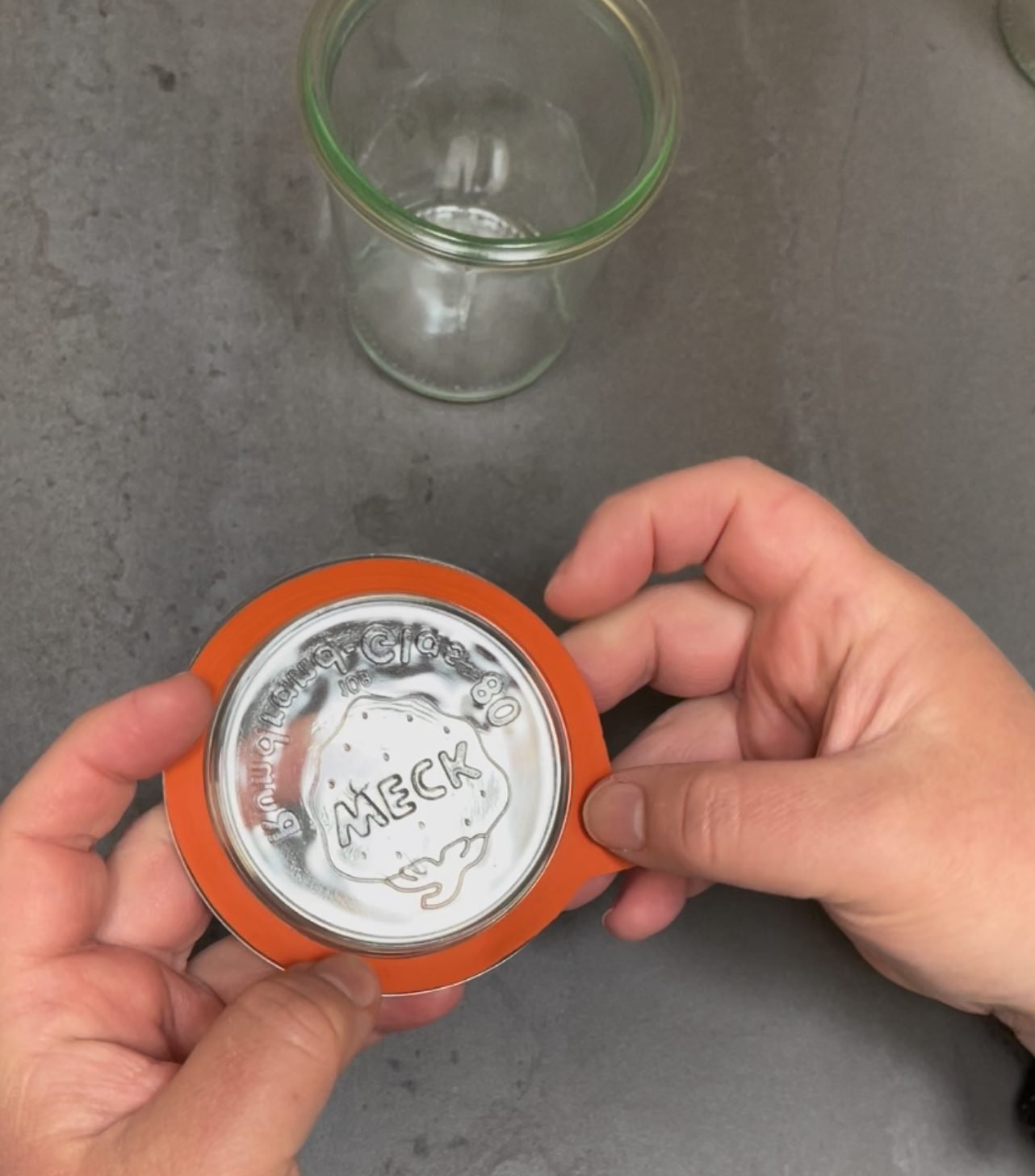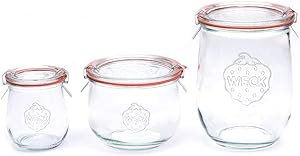What Are The WECK Jars, And How To Use Them For Canning
Views: 1065
If you’ve been seeking alternatives to Mason jars for canning, chances are you came across WECK canning jars. Well-known for their stylish looks, durability, and reusability, these jars have something to offer to everyone. And let’s be honest, there’s a certain almost religious belief in the quality of anything made in Germany as the pinnacle of quality. For us, deciding to learn about WECK jars and use them to make preserves was also an opportunity to reconnect with our European roots and can like Grandma used to. In this post, we’ll take you through our journey of discovering these German jars, learning how to can with them, and why we ultimately decided to stick with our Mason jars.
What are WECK jars?

WECK jars were created in Germany at the end of the 18th century specifically for home canning. J. WECK Company was founded in 1900 to sell WECK’s proprietary home-canning method perfectly exemplified in their glass jars. Since then, WECK has made this method popular not only in Germany and Europe but also worldwide. Reportedly, the original WECK jars had the key features of tabbed rubber gaskets, metal clamps and a glass lid. The WECK canning jars you can buy today will have the same features and the same sealing mechanism. WECK jars quickly gained popularity in Germany and many other European countries. Interestingly, Germans use “einwecken,” meaning “to put in Wecks,” to refer to the canning process, showing how closely intertwined canning and WECK jars are in Germany.
Image: Weck Glassworks – Bonn-Duisdorf, North Rhine-Westphalia, Germany. VMH, CC BY-SA 3.0, via Wikimedia Commons


Today, WECK offers various jar designs. In addition to canning, these jars are often used as sourdough starter containers, beverage carafes and containers for packaging delicatessens in European grocery stores. Unfortunately, manufacturing and selling just the glass jars weren’t enough to keep the company afloat. Despite attempts to keep the company going, WECK filed for bankruptcy in June 2023. So, if you’re a WECK fan, hold onto your jars—they could soon be collector’s items.
Assembling WECK glass jars
We bought our WECK Mold jars straight from a distributor in Canada, so we can give you a firsthand look at what to expect when you get these jars brand new.
Every WECK glass jar, regardless of the type you choose, comes un-assembled and includes:
- One glass jar
- One glass lid
- Two stainless steel metal clamps
- One natural rubber ring seal (gasket).
Additionally, a brand-new jar will have a protective plastic casing around the lid and the mouth of the jar. This casing keeps the lid attached to the jar and prevents dirt or debris from getting inside the jar.






To assemble the one of these jars, simply place the rubber ring onto the sealing rim of the lid, position it on top of the jar, and attach the canning clamps. Before you do that, make sure the clamps line up across from each other on the lid. Then, press them down until they click onto the jar’s rim. And that’s it! You’re good to go.
Cleaning and sterilizing WECK glass jars before canning
Just as any canning jars, WECK jars must be washed before use. Cleaning and sterilizing these jars is the same as cleaning and sterilizing Mason jars.
Washing WECK lids can be a bit tricky. The manufacturer’s advice on sterilizing these is also confusing. Through trial and error, we found the way that works the best. We recommend removing the rubber seals from the glass canning lids before washing them. Once done, wash glass lids like you would anything made of glass.
For the rubber gaskets, we recommend washing them carefully under warm, soapy water and then rinsing them with warm water. The manufacturer says to sterilize the glass lids with the rubber seal attached for 10 minutes in boiling water. However, we found problems with this method. Boiling a rubber gasket for 10 minutes can harm the rubber and make it wear out faster. Additionally, we discovered that the rubber gasket tends to come off when you put the lid with the gasket into boiling water.
Instead, we recommend placing the rubber gasket on the glass lid and then submerging them together into water that has just boiled (but is no longer boiling). Allow them to sit until you’re ready to use them on your filled jars. Just make sure not to leave them in hot water for more than 10 minutes.
This is how WECK canning jars work
When the jar is heated, the pressure inside increases relative to the pressure outside. This causes hot air, steam, and sometimes even a bit of liquid to escape between the rubber ring and the rim of the jar. The lid and rubber rings, held in place by the spring clamps, act like a one-way valve. They let air, steam, and some liquid out of the jar, but they don’t allow air or cooking water to get in. As the jar cools down after heating, a vacuum forms inside. The air pressure outside the jar pushes the lid down onto the rim, creating a tight seal.
Vacuum gets formed inside the WECK jar as it cools. Additionally, the air pressure outside the jar presses the lid down, which makes it seal firmly.
Canning with WECK
Firstly, after doing thorough research on WECK jars, we figured the manufacturer originally intended these jars to be used with open kettle canning. Despite that, we couldn’t quite understand how they’d work with inversion canning because the clamps on the lids tend to get in the way when you invert the can. Because these jars were invented and have stayed the same for over 100 years, way before the popularity of water bath canning, we think the manufacturer initially designed them in a way that lets the jar’s mechanics do the magic of sealing them without any further processing. While this seemed easy, we felt it was necessary to water bath our preserves.
If you plan to use these jars in a water bath, follow these steps:
- Pack the preserve into your sterilized WECK glass jar, leaving 1-inch head space.
- Cover with a lid.
- Apply clamps to the lid.
- Process in a water bath, like you would when using a Mason jar.
- Lift the jar from the water bath once the processing time finishes.
- Let it cool and test for seal.



Remember, WECK jars are European-made. Their sizes differ slightly from North American Mason jars. In line with the guidance of the National Center for Home Food Preservation, you might need to adjust the processing time for these jars, but we found it unnecessary.
Checking the seal on the processed preserves

As your preserve cools inside the WECK jar, visually examine the part of the rubber ring that sticks outside, also known as a tab. You should see the tab of the rubber ring facing downwards, just like a tong. This is the first sign that the seal was successful. Once the jar has cooled completely, you must remove the spring clamps. Once done, you can easily check to see if the jar is actually sealed by trying to gently lift the jar by the lid. This is the so-called lid-lifting test. If you can lift off the lid, the seal obviously failed, and you need to reprocess the jar.
Opening sealed WECK jars
One of the benefits of these jars is the ease with which they can be opened. You do not need and, as a matter of fact, must not use any bottle opener or sharp object to dislodge the lid. Instead, simply pull the tab away from the jar until you hear a hissing sound. This means air has entered the jar, breaking the vacuum created during processing, and you can now easily lift the lid and enjoy your preserve. Watch how this is done in practice.
Buy WECK jars on Amazon

Unlike Mason jars, it can be hard to find WECK jars, especially if you are located in North America. While you may accidentally stumble upon them at one of your favorite kitchenware stores, the best place to look for the WECK canning jars is on Amazon.

Comparing two types of canning jars
- Most of the Mason jars made in the USA and some made in China. In comparison, all WECK jars are made in Germany. When you buy WECK jars, you can count on the same high level of durability and quality found in other German-engineered products.
- These jars are a favorite among eco-conscious consumers who value longevity and versatility because all parts of these jars are completely reusable.
- Additionally, WECK jars are timelessly elegant, especially their juice and tulip jars, which is not what you can say about Mason jars. Serving juice from a WECK juice glass jar or preserves from their deli, deco, or tulip jars adds a touch of class to any occasion. The same can’t be said about Mason jars.
- Unlike Mason jars, WECK jars have a glass lid with a rubber gasket and metal clamps to secure the lid. By comparison, Mason jars have a two-piece metal lid with a flat metal disc and a threaded ring to hold it in place.
Why we are choosing Mason jars over WECK
Regardless of the classy WECK designs, we are not ready to ditch our Mason jars. The reason why we pick them over WECK, is the Mason jar’s simpler sealing mechnism. Fishing out a WECK glass lid and a gasket from the freshly boiled water, especially when you are in a hurry to process a dozen preserves, can be a chore. Keeping a gasket attached to the glass lid while removing them from the freshly boiled water adds to the challenge. Once you tried using both types of jars in one canning round, you’ll appreciate the simplicity of Mason jars. We’ve even made a video demonstrating our struggles with the WECK Mold jars, which you need to see to truly understand our point.
Frequently asked questions
Should I remove the spring clamps from the WECK jars?
Don’t those WECK jars look cool with their metal clamps on? We get it! But honestly, it’s not a great idea to leave them on. You want to remove those clams to be able to perform a lift test. Plus, putting the clamps back on after the test and letting them stay could prevent the lid from popping off if gases build up in a spoiled preserve.
Are these jars dishwasher, microwave and oven safe?

WECK glass jars have a very thick glass, far thicker than the glass you’ll find in most Mason jars. You can safely use WECK jars in a dishwasher and microwave. We do however recommend removing the rubber gaskets prior to microwaving or loading the lid into the dishwasher.
WECK jar distributors, as well as several bloggers, claim these jars to be oven-safe. To prove the point, they share pictures of baked goods in WECK jars. However, we’re puzzled as to why anyone would want to bake in them.
How much do WECK jars cost?
The answer to this question may vary depending on your location. If you live in North America, like us, you’ll probably find that WECK jars are more expensive than Mason jars. However, once you factor in the reusable lid and better glass quality, the price gap shrinks after you get half a dozen uses out of your WECK jars
Are WECK jars freezer safe?
While WECK jars are said to be practically indestructible, as per the WECK jar manufacturer, you should only use the WECK Mold jars together with their plastic lids for freezing. These covers will allow for expansion and contraction. Do not use the glass lid, ring, and clamps to freeze in jars.
When freezing food in glass jars, remember to leave enough space at the top for expansion. Typically, you should leave about an inch of space between the food and the jar’s top.
Also, be cautious of extreme temperature changes. Cool hot foods, like soups, before freezing them in jars. Don’t put frozen jars directly into hot water or the microwave, as this could cause them to crack.
To prevent “thermal shock,” the temperature difference between the glass and the surrounding environment should not exceed 122 °F (50 degrees Celsius).
Can WECK jars be used in pressure canner?
Firstly, we want to clarify that we don’t have personal experience using these jars in a pressure canner. The details we provide here are from the distributor’s website and what we were told when we picked up our new WECK jars order. The answer to the question is that WECK jars can indeed be used for pressure canning.
Canning Equipment We Use – Honest Reviews & Shopping Links:
Note: Every item we review was purchased with our own money. These posts are not sponsored – just our honest take on the jars, lids, and other canning gear we actually use.
We’ve added curated Amazon links for your convenience. If you buy through them, we may earn a small commission (at no extra cost to you).







